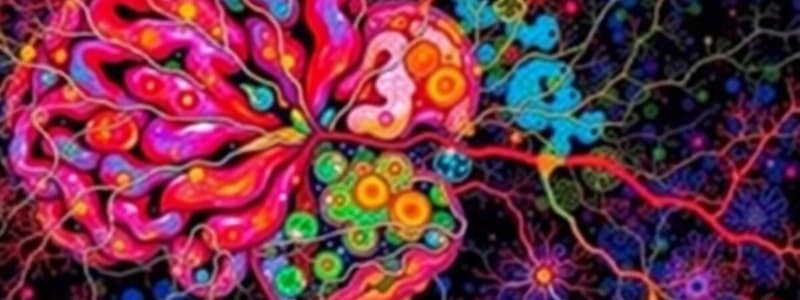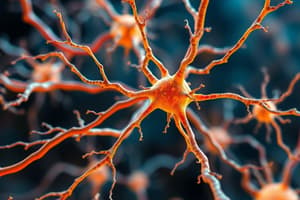Podcast
Questions and Answers
What is the primary function of receptors located on the dendrites of neurons?
What is the primary function of receptors located on the dendrites of neurons?
- Receive signals from other neurons (correct)
- Terminate neurotransmitter activity
- Produce neurotransmitters
- Conduct electrical impulses away from the neuron
Which neurotransmitter is involved in muscle action and memory?
Which neurotransmitter is involved in muscle action and memory?
- Dopamine
- Serotonin
- Acetylcholine (correct)
- Norepinephrine
What is the primary role of inactivators in the nervous system?
What is the primary role of inactivators in the nervous system?
- To terminate neurotransmitter activity (correct)
- To convert neurotransmitters into hormones
- To strengthen synaptic connections
- To enhance neurotransmitter activity
Which structure divides the right and left hemispheres of the brain and facilitates communication between them?
Which structure divides the right and left hemispheres of the brain and facilitates communication between them?
Which lobe of the brain is primarily responsible for processing visual information?
Which lobe of the brain is primarily responsible for processing visual information?
What function is primarily associated with the hypothalamus?
What function is primarily associated with the hypothalamus?
What term describes the convoluted elevations in the cerebrum?
What term describes the convoluted elevations in the cerebrum?
What condition is associated with a deficiency of dopamine in the basal nuclei?
What condition is associated with a deficiency of dopamine in the basal nuclei?
What does the Central Nervous System (CNS) primarily consist of?
What does the Central Nervous System (CNS) primarily consist of?
Which function of the nervous system is responsible for interpreting sensory information?
Which function of the nervous system is responsible for interpreting sensory information?
Which cells are the most abundant in the CNS and perform supportive roles?
Which cells are the most abundant in the CNS and perform supportive roles?
How do sensory nerves function within the nervous system?
How do sensory nerves function within the nervous system?
What role do ependymal cells play in the nervous system?
What role do ependymal cells play in the nervous system?
What is the primary function of motor nerves?
What is the primary function of motor nerves?
Identify the part of the neuron that receives signals from other neurons.
Identify the part of the neuron that receives signals from other neurons.
What is the main role of interneurons in the nervous system?
What is the main role of interneurons in the nervous system?
What is the role of myelination in the nervous system?
What is the role of myelination in the nervous system?
What type of cell forms the myelin sheath in the PNS?
What type of cell forms the myelin sheath in the PNS?
During which phase of the action potential does Na+ rush into the neuron?
During which phase of the action potential does Na+ rush into the neuron?
How does saltatory conduction affect nerve impulse transmission?
How does saltatory conduction affect nerve impulse transmission?
What distinguishes white matter from gray matter in the nervous system?
What distinguishes white matter from gray matter in the nervous system?
What is the function of the synaptic cleft?
What is the function of the synaptic cleft?
What is the effect of K+ diffusion during repolarization?
What is the effect of K+ diffusion during repolarization?
What are small clusters of cell bodies in the PNS called?
What are small clusters of cell bodies in the PNS called?
What is the primary function of the medulla oblongata?
What is the primary function of the medulla oblongata?
Which layer of the meninges is the thickest?
Which layer of the meninges is the thickest?
What is the function of the reticular formation?
What is the function of the reticular formation?
What characteristic is associated with the limbic system?
What characteristic is associated with the limbic system?
Which component of the brain is primarily responsible for regulating breathing rate?
Which component of the brain is primarily responsible for regulating breathing rate?
Which statement about cerebrospinal fluid (CSF) is not correct?
Which statement about cerebrospinal fluid (CSF) is not correct?
What is the primary role of the blood-brain barrier?
What is the primary role of the blood-brain barrier?
Which brain structure is involved in processing reflex centers for vision and hearing?
Which brain structure is involved in processing reflex centers for vision and hearing?
Study Notes
Central Nervous System (CNS) and Peripheral Nervous System (PNS)
- CNS includes the brain (cranial cavity) and spinal cord (spinal cavity).
- PNS consists of nerves connecting the CNS to the rest of the body.
- CNS functions: sensory (gathering information), integrative (interpreting information), and motor (carrying information to muscles and glands).
Neuroglia (Glial Cells)
- Most abundant CNS cells; support, nourish, protect, and insulate neurons.
- Do not conduct nerve impulses.
- Astrocytes: most abundant and diverse, provide structural support and contribute to the blood-brain barrier.
- Ependymal cells: line brain cavities and assist in cerebrospinal fluid (CSF) formation.
Neurons
- Specialized for electrical transmission.
- Types: sensory (afferent; PNS to CNS), motor (efferent; CNS to PNS), and interneurons (integrate information within CNS).
- Neuron parts: dendrites (receive signals), cell body (contains nucleus, integrates signals), axon (transmits signals).
- Axon structure: myelin sheath (insulates axon; formed by oligodendrocytes in CNS, Schwann cells in PNS; neurilemma in PNS allows regeneration), Nodes of Ranvier (facilitate saltatory conduction).
- White matter (myelinated axons) vs. gray matter (unmyelinated axons, cell bodies, interneurons, synapses).
- Nuclei (CNS) and ganglia (PNS) are clusters of cell bodies.
Nerve Impulse (Action Potential)
- Electrical signal conveying information along a neuron.
- Stages: resting membrane potential (K+ outward leak; inside negative, outside positive), depolarization (Na+ influx; inside positive, outside negative), repolarization (K+ outward diffusion; inside negative, outside positive).
- Myelin sheath and saltatory conduction (impulse jumps between Nodes of Ranvier) increase speed.
Synapse
- Junction between neurons for chemical information transfer.
- Components: synaptic cleft (space between neurons), receptors (on dendrites, receive neurotransmitters), neurotransmitters (chemicals; e.g., acetylcholine and norepinephrine), inactivators (terminate neurotransmitter activity).
Brain: Structure and Function
- Cerebrum: largest part; right and left hemispheres connected by corpus callosum; four lobes (frontal – executive functions, primary motor cortex, Broca's area; parietal – primary somatosensory area; temporal – primary auditory cortex, olfactory area, Wernicke's area; occipital – visual cortex); cerebral cortex (gray matter, higher mental functions); white matter (connects brain parts); gyri (elevations); sulci (grooves); basal nuclei (regulate movement, facial expression; dopamine deficiency causes Parkinson's disease).
- Diencephalon: thalamus (sensory relay station); hypothalamus (regulates temperature, water balance, metabolism, ANS).
- Brainstem: midbrain (sensory/motor relay, reflexes), pons (breathing regulation), medulla oblongata (vital center – heart rate, blood pressure, respiration; vomiting center; opioid sensitive).
- Cerebellum: coordinates voluntary muscle activity, posture, and balance.
- Limbic system: emotional brain.
- Reticular formation: alerts cerebral cortex, regulates muscle tone; reticular activating system (sleep-wake cycle; NREM and REM sleep).
Brain Protection
- Bone (cranium, vertebral column).
- Meninges: dura mater (outermost, dural sinuses), arachnoid mater (middle, subarachnoid space with CSF), pia mater (innermost, blood vessels).
- Cerebrospinal fluid (CSF): formed in ventricles by choroid plexus; protects, nourishes, removes waste.
- Blood-brain barrier.
Studying That Suits You
Use AI to generate personalized quizzes and flashcards to suit your learning preferences.
Related Documents
Description
Test your knowledge of the Central Nervous System (CNS) and Peripheral Nervous System (PNS). This quiz covers the functions of neurons and the role of glial cells. Understand how these components work together to support bodily functions.




